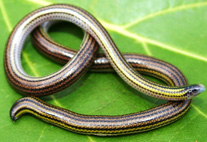Abstract
Three new blind snake species of the genus Epictia are described based on material collected in the Peruvian Regions Amazonas, Cajamarca and La Libertad. All three species are well differentiated from all congeners based on characteristics of their morphology and coloration. They share 10 scale rows around the middle of the tail and possess two supralabials with the anterior one in broad contact with the supraocular. Epictia septemlineata sp. nov. has 16 subcaudal scales, 257 mid-dorsal scale rows, a yellowish-white rostral, and a black terminal spine. Epictia vanwallachi sp. nov. exhibits 16 subcaudals, 188 mid-dorsal scale rows, a grayish-brown rostral, and a yellow terminal spine. Epictia antoniogarciai sp. nov. features 14–18 subcaudals, 195–208 mid-dorsal scale rows, a bright yellow or yellowish-white rostral, and the terminal spine and terminal portion of the tail yellow. All three species were collected in the interandean dry forest valleys of the Marañón River and its tributaries. This region is an area of endemism and warrants further attention from systematic and conservation biologists.

